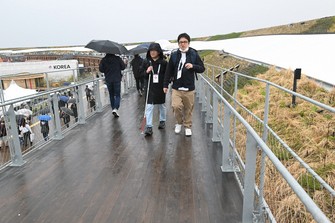
Reporter Ayato Saki, center, walks with a sighted colleague along a section of Expo 2025 Osaka, Kansai’s Grand Ring walkway that has no tactile paving blocks to help guide visually impaired visitors, at the Expo venue in Osaka’s Konohana Ward, April 13, 2025. (Mainichi/Takehiko Onishi)
OSAKA — As a completely blind person, this Mainichi Shimbun reporter was alarmed and felt at a loss atop the “Grand Ring,” the large structure bounding the Expo 2025 Osaka, Kansai venue, when the tactile guideway blocks I had been relying on suddenly ended.
I had been following the raised linear braille blocks, which indicate the direction to go, along about a 2-kilmeter circular walkway. Eventually, I reached a point where these guiding tiles ceased unexpectedly.
The walkway, about 12 meters above ground, split into two, one branch a slope going up to the highest level, some 20 meters high. At the fork, a series of dotted tactile warning tiles — meant to alert pedestrians to use caution — span the pathway, but no directional guide tiles follow beyond this point. I was unaware of this until informed by a sighted reporter who accompanied me.
The circular shape of the rooftop walkway itself creates a barrier for blind visitors like myself, making it impossible to know one’s precise location within the endless loop. I found no braille signage on the corridor’s handrails, nor any audible guidance.
Japan invented tactile paving in the 1960s as an innovative tool enhancing navigation and safety for visually impaired people. The Expo’s ring structure, billed as one of the largest wooden buildings in the world, is meant to represent a message of “unity in diversity.” With the Expo having opened on April 13, the venue should truly become an inclusive space where everyone can equally enjoy themselves, whether they have disabilities or not. It appears organizers still lack that last crucial step of imagination necessary to achieve genuine accessibility.
(Japanese original by Ayato Saki, Braille Mainichi Department)


AloJapan.com